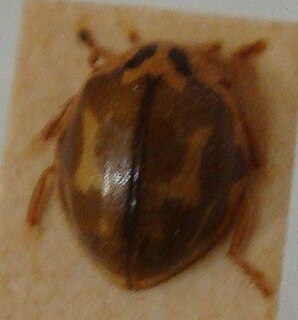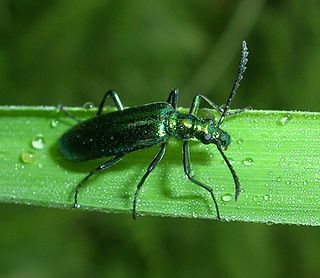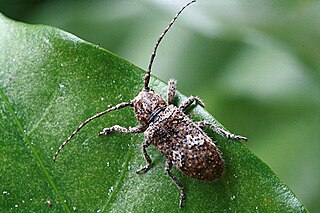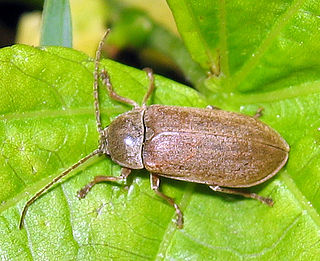
Coccinella leonina, common name orange-spotted ladybird, is a species of ladybird native to New Zealand. It is black with orange spots. It is present in a variety of habitats and is a predator species.

Harmonia antipodum, known as the antipodean ladybird, is a species of ladybird beetle indigenous to New Zealand, though sometimes mistaken for a related non-native species, Harmonia conformis. They are a brown colour, and about 3 mm long, while H. conformis is much larger and more conspicuously coloured.

Prionoceridae is a small family of beetles, in the suborder Polyphaga. They form a group within the cleroid beetles and were formerly treated as a subfamily (Prionocerinae) within the family Melyridae. Very little is known of their life history but most species are pollen feeders as adults and occur in large numbers during spring or the host flowering season. Larvae are predatory or feed on decomposing wood.
Boganiidae is a family of beetles, in the suborder Polyphaga. Members of the family are found in southern Africa, Australia and New Caledonia. Adults and larvae are pollenivorous, feeding on the pollen of cycads and Myrtaceae, Meliaceae, Cunoniaceae and Elaeocarpaceae angiosperms. Metacucujus and Paracucujus act as pollinators for cycads Encephalartos and Macrozamia respectively. This association with cycads goes back to at least the Mid-Cretaceous, with an extinct form being found with preserved cycad pollen in 99 million year old Burmese amber.

The Mycetophagidae or hairy fungus beetles are a family of beetles in the large suborder Polyphaga. The different species are between 1.0 and 6.5 mm in length. The larvae and adults live in decaying leaf litter, fungi, and under bark. Most species feed on fungi. Worldwide, the 18 genera contain around 200 species.

The Epilachninae are a subfamily of the family of lady beetles, the Coccinellidae, in the order Coleoptera. Superficially, they look much like other ladybirds in the larger subfamily Coccinellinae, but they differ importantly in their biology, in that the members of the subfamily are largely or completely leaf-feeding herbivores rather than being predators. Accordingly, several members of the subfamily are crop pests, and sometimes cause locally serious crop losses.
Microweiseini is a tribe of ladybird beetles.

Rhytiphora bankii is a species of beetle in the family Cerambycidae. It was described by Johan Christian Fabricius in 1775, originally under the genus Lamia. It is known from Australia, the Philippines, Borneo, Java, Micronesia, New Guinea, Hawaii, Moluccas, Sumatra, Vietnam, and has been introduced into Japan. It feeds on Agave sisalana. The Australian species of Prosoplus were synonymised with Rhytiphora in 2013.

Dascillidae is a family of soft-bodied plant beetles in the order Coleoptera. There are at least 15 genera and about 80 described species in Dascillidae. Dascillidae together with Rhipiceridae form the super family Dascilloidea.

Rhipiceridae is a family of cedar beetles, also known as cicada parasite beetles, in the order Coleoptera. Rhipiceridae and Dascillidae form the super family Dascilloidea.

Cyclaxyridae are a family of beetles in the superfamily Cucujoidea. The only living genus is Cyclaxyra, with two species endemic to New Zealand. Other species have been named from fossils. They are also known as sooty mould beetles due to the association of Cyclaxyra with sooty mould. The extant species are mycophagous, feeding on spores, conidia, and hyphae.

Beutelius is a small genus of ommatid beetles native to Australia. It is only one of three extant genera in the family, alongside Tetraphalerus and Omma. It currently contains 4 species, three of which were originally assigned to Omma and it is distinguished from Omma by the presence of flattened, ribbed scales covering most areas.

Diekeana is a genus of beetle in the family Coccinellidae, formerly included within the genus Epilachna.
Chazeauiana is a genus of beetle in the family Coccinellidae, formerly included within the genus Epilachna.

Cyclocranium is a genus of beetles in the long-horned beetle family and the tribe Pseudocephalini. It contains a single species, Cyclocranium swierstrae.
Hong glorious is a species of ladybird beetle in the genus Hong.

Rhipicera is a genus of beetle belonging to the family Rhipiceridae.

Rhipicera carinata is a species of beetle in the genus Rhipicera.
Rhipicera femorata is a species of beetle in the genus Rhipicera.
Rhipicera mystacina is a species of beetle in the genus Rhipicera.











